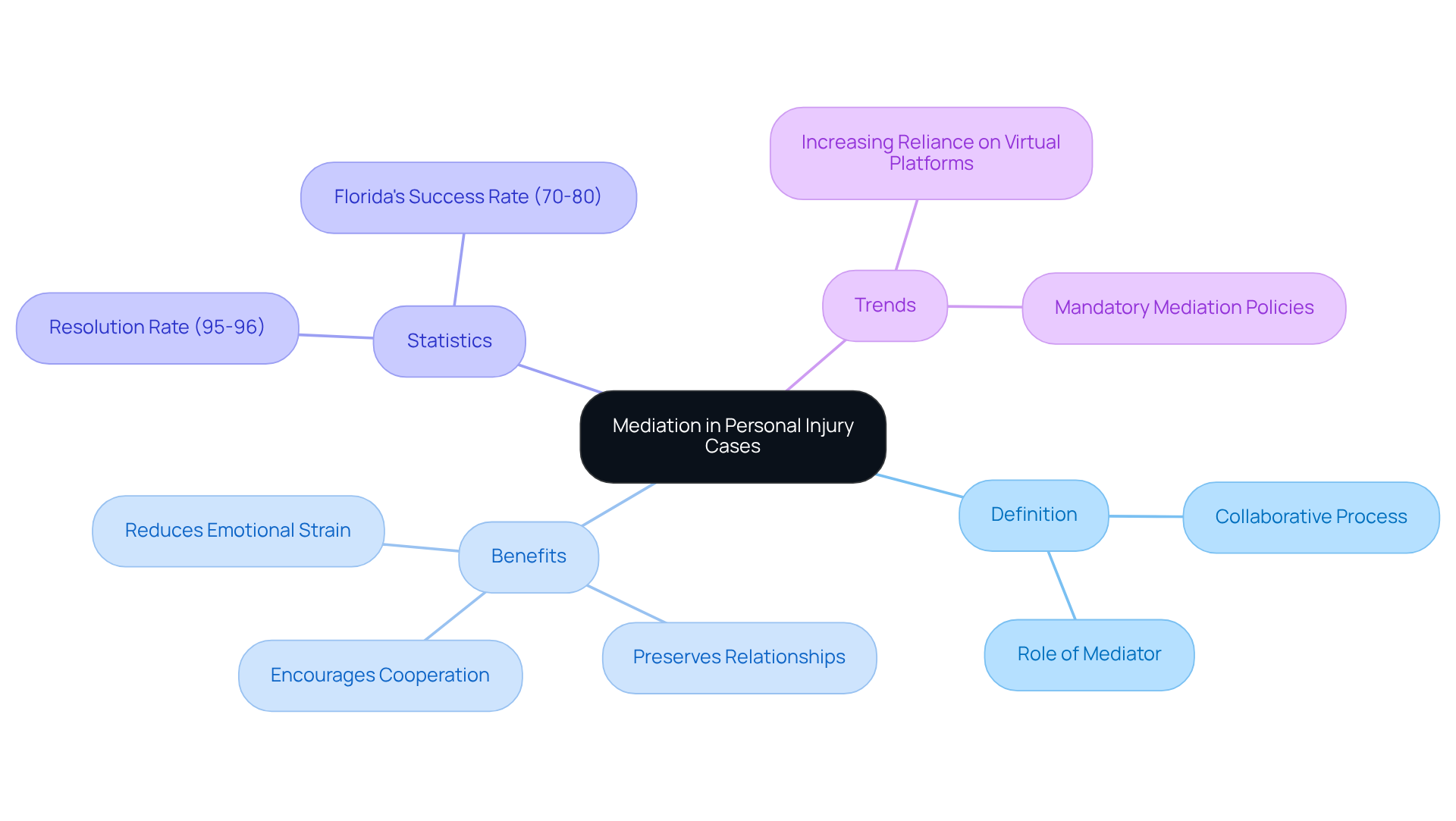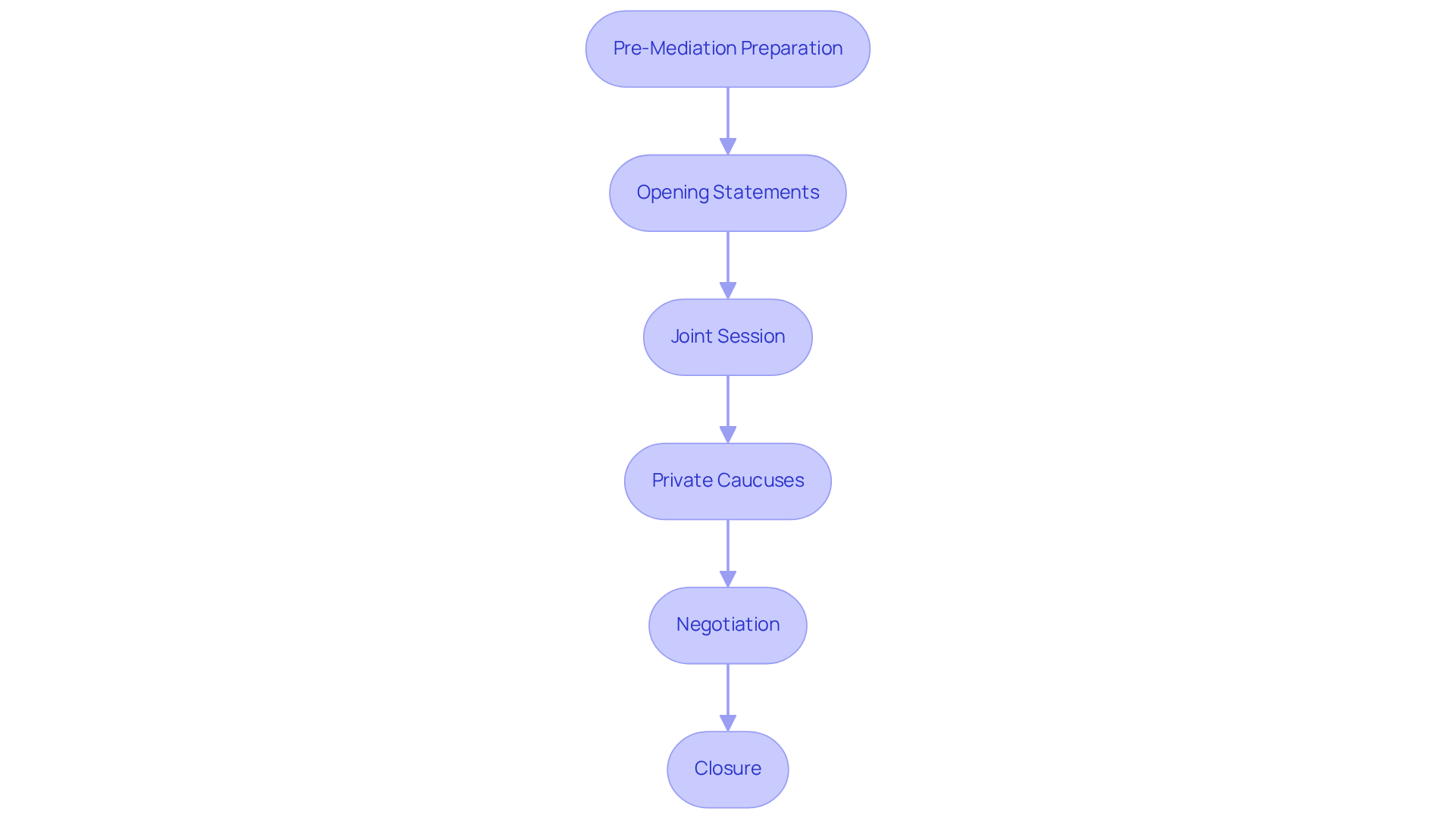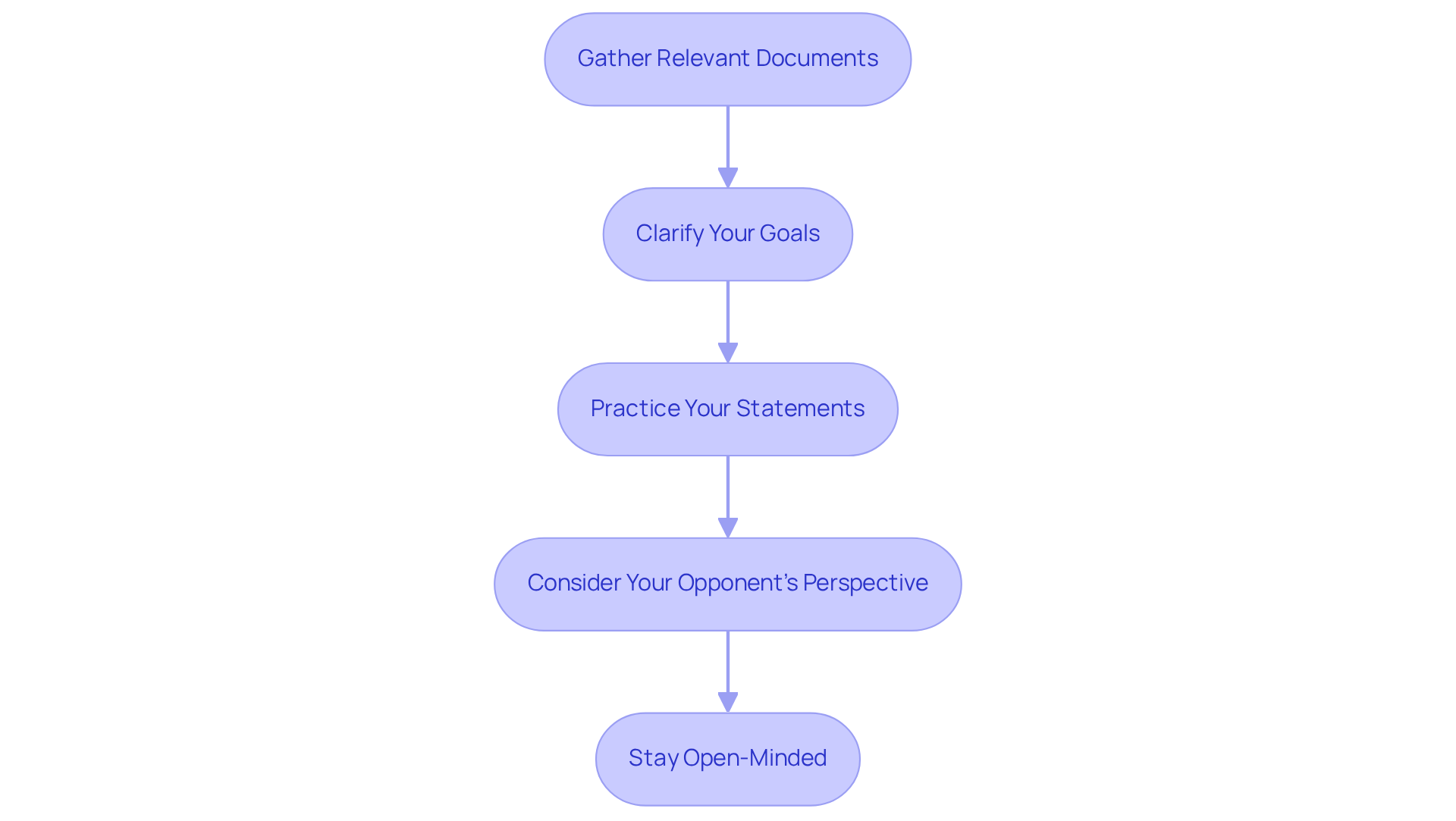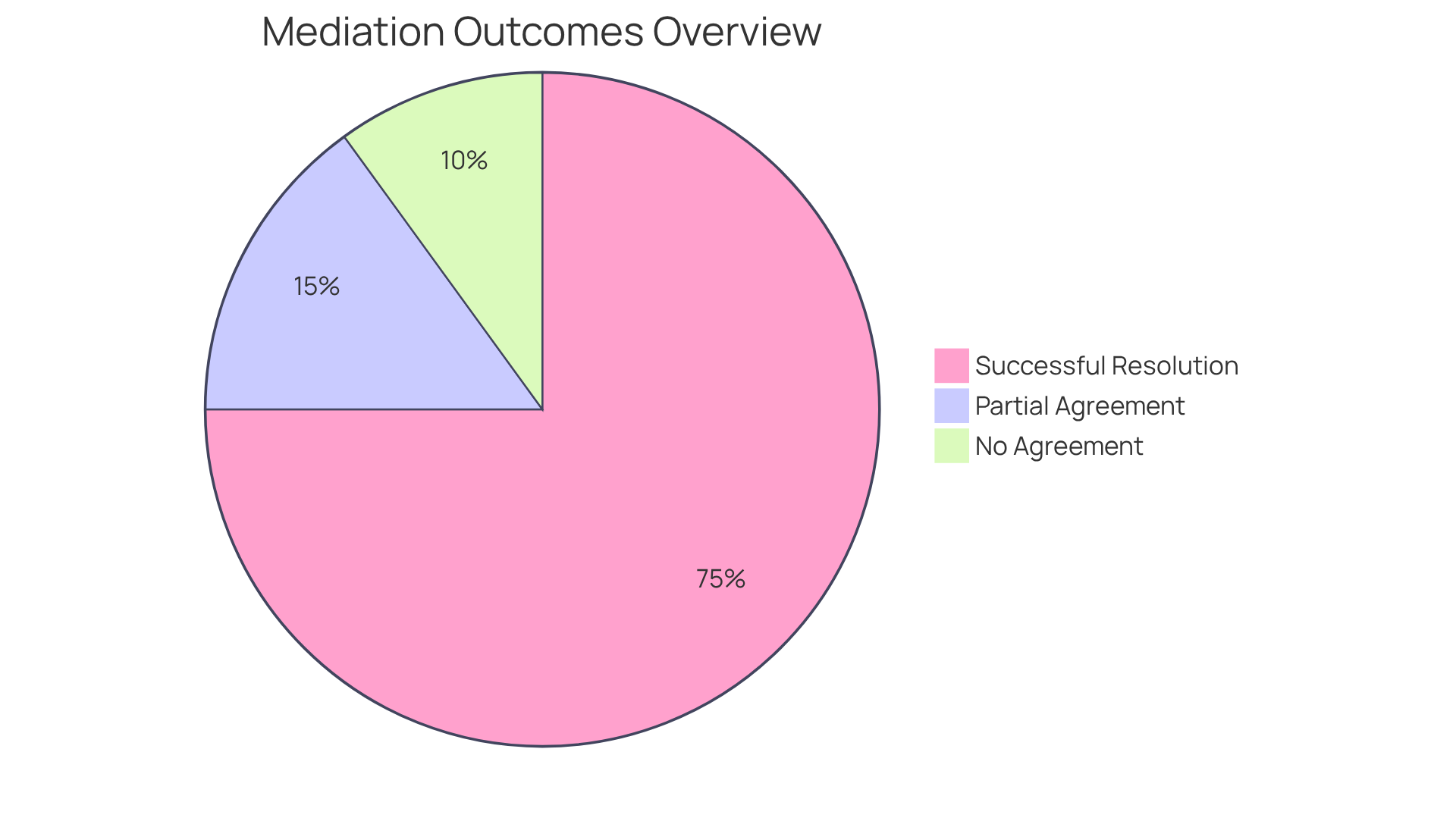
Mediation for Personal Injury: Steps, Roles, and Outcomes Explained
Overview
Mediation in personal injury cases is more than just a process; it’s a collaborative journey where a neutral facilitator guides both parties towards a resolution that respects their needs. Unlike the often adversarial nature of litigation, mediation opens the door to open communication and cooperation.
Have you ever felt overwhelmed by conflict? Mediation not only eases that emotional burden but also has a remarkable success rate—around 70-80% of cases find a positive resolution. This approach not only alleviates stress but also helps preserve important relationships.
Imagine navigating this difficult time with support and understanding. Mediation offers a compassionate alternative, allowing for a space where your voice matters. It encourages a dialogue that can lead to healing and mutual agreement, rather than further discord. We believe that every individual deserves to feel heard and respected during such challenging moments.
If you’re considering mediation, know that you’re not alone. This process can be a powerful step towards resolution, fostering a sense of partnership and support. Let’s embrace this opportunity to move forward together, with empathy at the forefront.
Introduction
Mediation has emerged as a preferred method for resolving personal injury disputes, offering a more collaborative and less adversarial alternative to traditional litigation. This process not only allows us to engage in open dialogue but also fosters understanding and cooperation, significantly reducing emotional strain. But what happens when the stakes are high, and the outcomes uncertain?
Exploring the steps, roles, and potential results of mediation can illuminate how this compassionate approach can lead to effective resolutions, even in the most challenging situations. Together, we can navigate this journey towards resolution, ensuring that your voice is heard and your concerns are addressed.
Define Mediation in Personal Injury Cases
Mediation for personal injury cases is a collaborative process where an unbiased facilitator helps conflicting individuals achieve a mutually agreeable resolution. Unlike litigation, which can often feel adversarial and formal, mediation encourages open communication and cooperation. The mediator plays a crucial role in facilitating dialogue, allowing both parties to express their concerns and interests. This approach is especially beneficial in mediation for personal injury cases, where emotional factors can significantly influence the outcome.
Did you know that around 95-96% of personal injury cases are resolved prior to trial? This statistic highlights the efficiency of negotiation as a favored approach for resolution. In Florida, conflict resolution has achieved a success rate of around 70-80% across both family and civil cases, emphasizing its importance in resolving disputes swiftly and amicably. For example, insurance claim negotiations in Florida have reported success rates of 70% to 80%, demonstrating how the process can clarify policy limits and expedite settlements.
Mediators emphasize the many benefits of mediation for personal injury cases, noting that it not only reduces emotional strain on parties but also preserves relationships, which is vital. The non-adversarial nature of the process promotes joint decision-making and voluntary agreements, leading to reduced resentment and an increased likelihood of adherence to the settlement terms. Have you considered how recent trends suggest an increasing reliance on virtual facilitation platforms? These platforms have proven to improve engagement and participation, especially in employment and insurance conflicts.
In general, mediation for personal injury emerges as a practical and effective approach for personal injury cases, allowing individuals to settle their conflicts efficiently while reducing expenses and tension. Remember, mediation can be a nurturing path toward resolution, fostering understanding and cooperation. We invite you to explore this compassionate option of mediation for personal injury needs.

Outline the Steps of the Mediation Process
Navigating personal injury disputes can be overwhelming, but mediation for personal injury provides a compassionate pathway to resolution. Here’s how it typically unfolds:
-
Pre-Mediation Preparation: First, all parties agree to engage in mediation and select a qualified facilitator. This important step involves gathering essential documents and clearly outlining each group's perspective, setting the stage for a productive session.
-
Opening Statements: Each side then shares their viewpoint on the dispute. This allows the facilitator to gain a comprehensive understanding of the issues at hand, fostering an atmosphere of empathy and respect.
-
Joint Session: The facilitator encourages open dialogue between the groups, nurturing communication and inspiring them to explore their underlying interests. This is where real connection can begin.
-
Private Caucuses: Sometimes, sensitive issues arise. The facilitator may hold individual discussions with each group, creating a safe space to address these matters and brainstorm potential solutions confidentially.
-
Negotiation: Guided by the facilitator, the involved individuals engage in discussions aimed at achieving mutually agreeable terms. Here, the facilitator helps clarify points and identify shared interests, making the process feel collaborative.
-
Closure: If an agreement is reached, the facilitator assists in drafting a settlement document. If not, the parties may consider alternative conflict resolution methods, such as arbitration or litigation.
This structured approach not only enhances the likelihood of a successful outcome but also clarifies the issues at hand in mediation for personal injury, paving the way for future legal steps if necessary. Remember, you are not alone in this process; support is available every step of the way.

Explain the Role of the Mediator
The mediator plays a vital role in the mediation for personal injury process, carrying several key responsibilities that greatly influence the outcome of disputes.
- Facilitating Communication: The mediator encourages open dialogue, ensuring that both parties feel heard and understood. This is essential for building trust and fostering cooperation, which can be so comforting during challenging times.
- Managing the Process: They guide the mediation sessions, keeping discussions focused and productive while maintaining a respectful environment. This respectful atmosphere is crucial for effective resolution, allowing everyone to feel safe in expressing their thoughts.
- Identifying Interests: By assisting in revealing the underlying interests of each side, the facilitator can lead to more innovative and satisfactory solutions that truly address the core issues at hand. Have you ever felt that your concerns weren’t fully acknowledged? This process aims to ensure that doesn’t happen.
- Promoting Cooperation: The facilitator nurtures a cooperative environment, allowing groups to unite in discovering shared interests. This unity is essential in achieving a mutually advantageous agreement, bringing everyone closer to a resolution that feels right.
- Maintaining Neutrality: Remaining impartial throughout the process, the facilitator ensures that no party feels disadvantaged or pressured. This neutrality is fundamental to the integrity of the mediation process, allowing all participants to voice their concerns without fear of prejudice.
In cases involving mediation for personal injury, the average number of facilitators usually varies from one to three, depending on the complexity of the dispute. The effectiveness of intermediaries is often highlighted in case studies, illustrating how their impartial position and facilitative abilities can lead to successful resolutions. Expert perspectives reinforce the significance of neutrality in facilitation, creating a just process where all voices matter.
If groups cannot find shared understanding during negotiation, they may need to explore alternative choices, such as arbitration or a civil trial. Ultimately, the responsibilities of the mediator in mediation for personal injury are crucial for guiding the parties toward a resolution that is satisfactory for everyone involved.
Furthermore, adequate preparation for the process can greatly impact the result. It’s essential for participants to engage in comprehensive preparation prior to the session, ensuring they are ready to embark on this journey together.

Prepare Effectively for Mediation Sessions
To prepare effectively for mediation sessions, let’s consider some important steps together:
-
Gather Relevant Documents: Start by compiling essential paperwork, such as medical records, accident reports, and any correspondence related to the dispute. Common documents in personal injury negotiations may include insurance policies and witness statements. This documentation serves as the foundation for your case and can significantly influence the negotiation process.
-
Clarify Your Goals: It’s crucial to clearly identify your objectives for mediation, including your ideal outcome and any non-negotiable points. Understanding your goals will help you stay focused during discussions and advocate effectively for your interests.
-
Practice Your Statements: Rehearse how you will present your case, emphasizing clear and concise communication. Practicing your statements can boost your confidence and ensure that you convey your perspective effectively.
-
Consider Your Opponent's Perspective: Understanding the other side's position and interests is essential. As mediator Rachel Gupta wisely states, "As a mediator, I encourage parties to keep an open mind and to try and think about the issues in dispute from their adversary’s perspective." This understanding can help uncover shared interests and foster a more cooperative environment during conflict resolution.
-
Stay Open-Minded: Approach the discussion with a willingness to listen and explore various solutions. Flexibility can lead to better outcomes, as it opens the door for creative problem-solving and the potential for reaching a mutually beneficial agreement. Maintaining a calm and respectful demeanor throughout the process is also vital for constructive dialogue.
By implementing these strategies, you can enhance your preparedness for negotiations, ultimately leading to more effective and satisfactory resolutions through mediation for personal injury cases. For instance, a case study titled "Overcoming Impasse through Creative Thinking" illustrates how mediators can assist clients in brainstorming solutions when they feel stuck, leading to unexpected resolutions. This highlights the importance of being receptive to different methods during conflict resolution.

Explore Potential Outcomes of Mediation
The outcomes of mediation in personal injury disputes can vary significantly, often falling into three main categories:
- Successful Resolution: In many cases, parties achieve a mutually acceptable agreement, culminating in a written settlement that clearly outlines the terms. Did you know that roughly 70-80% of negotiations in mediation for personal injury lead to successful outcomes? This statistic highlights the effectiveness of mediation for personal injury as a method. A mediator plays a crucial role in mediation for personal injury by aiding communication between groups, helping them discover solutions to their conflicts, while refraining from offering therapy, counseling, or legal guidance.
- Partial Agreement: Occasionally, mediation for personal injury leads to the resolution of certain issues while leaving others unresolved. This scenario may necessitate further negotiations or even litigation to address outstanding matters. Have you ever found yourself in a situation where some issues were resolved, but others lingered? It can be a challenging place to be.
- No Agreement: If consensus cannot be achieved, involved individuals may choose alternative resolution methods, such as arbitration or litigation.
Regardless of the outcome, mediation for personal injury often provides valuable insights into the dispute. Through mediation for personal injury, it allows parties to better understand each other's perspectives and interests. This comprehension can promote enhanced communication and connections in future interactions, making mediation for personal injury a valuable pursuit even when a full agreement is not attained.
Furthermore, it is crucial to recognize that what is expressed during mediation for personal injury is confidential, offering a secure setting for candid dialogue. The principle of self-determination in mediation for personal injury is of utmost importance, ensuring that you, the parties involved, maintain control over the process. Together, we can navigate these challenges with understanding and compassion.

Conclusion
Mediation for personal injury cases emerges as a compassionate alternative to traditional litigation, creating a space where parties can collaboratively find resolutions. By fostering open communication and cooperation, mediation not only eases the emotional strain often tied to disputes but also increases the chances of achieving satisfying outcomes.
As we reflect on the key aspects of the mediation process, we see the essential steps involved, the crucial role of the mediator, and the potential positive outcomes that can arise. This structured approach, with an emphasis on preparation and understanding each party's perspective, highlights how effective mediation can be in resolving personal injury conflicts. The statistics reveal high success rates, underscoring mediation's value as a preferred path for dispute resolution.
Ultimately, embracing mediation for personal injury cases can lead to not just practical resolutions but also improved relationships between parties. The insights gained during this process can pave the way for better communication in the future. Engaging in mediation is a proactive step toward resolution; exploring this compassionate option can transform conflicts into opportunities for understanding and cooperation.
Have you considered how mediation might benefit your situation? It’s a nurturing approach that invites all parties to work together, fostering an environment of support and empathy. Let’s take that step towards healing and resolution together.
Frequently Asked Questions
What is mediation in personal injury cases?
Mediation for personal injury cases is a collaborative process where an unbiased facilitator helps conflicting individuals reach a mutually agreeable resolution. It encourages open communication and cooperation, contrasting with the adversarial nature of litigation.
What are the benefits of mediation for personal injury cases?
Mediation reduces emotional strain, preserves relationships, promotes joint decision-making, and leads to voluntary agreements, which can decrease resentment and increase adherence to settlement terms.
What is the success rate of mediation in personal injury cases?
Approximately 95-96% of personal injury cases are resolved prior to trial, with conflict resolution in Florida achieving a success rate of around 70-80% across family and civil cases.
What are the steps involved in the mediation process?
The mediation process typically involves the following steps: 1. Pre-Mediation Preparation: Agreeing to mediate and selecting a facilitator, along with gathering essential documents. 2. Opening Statements: Each side shares their viewpoint to foster understanding. 3. Joint Session: Open dialogue is encouraged to explore underlying interests. 4. Private Caucuses: Individual discussions may occur to address sensitive issues. 5. Negotiation: Guided discussions aim to achieve mutually agreeable terms. 6. Closure: If an agreement is reached, a settlement document is drafted; if not, alternative conflict resolution methods may be considered.
How does the mediation process help in personal injury disputes?
The structured approach of mediation enhances the likelihood of a successful outcome, clarifies the issues at hand, and provides support throughout the process, paving the way for future legal steps if necessary.
Are there any recent trends in mediation?
Recent trends indicate an increasing reliance on virtual facilitation platforms, which have proven to improve engagement and participation, especially in employment and insurance conflicts.


